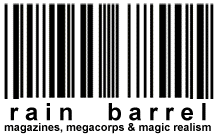
December 28, 2001

December 28, 2001

|
Perhaps against my better judgment, I resubscribed to Adbusters Magazine. I was tempted not to because I find the magazine increasingly unsatisfying. With each issue, the magazine drifts further from the reader seeking right words, deeds and livelihood. The magazine seems to become more angry, more confrontational, more graphic and more visceral with time. But in the end, I sent off my check because Adbusters still fulfills my primary criteria of a good magazine: it gets me thinking. And the latest issue of Adbusters has done that. The January/February 2002 Adbusters is a split issue with two different covers. There's a "You're Either With Us" cover of a scarcely scorched American flag and on the flipside is a "Or Against Us" cover with a mostly scorched American flag. It's as if Adbusters is saying "either way, you are going to get burned." When you open up the magazine you find a strangely coloured image of a flying dove on a black streaky surface in the center spread. Over the image is type. One side reads "The American way of life is negotiable" and on the other, upside-down, "The American way of life is not negotiable." On the "not negotiable" page is also the word "desire" and an arrow pointing up. On the other, the word "desire" and an arrow pointing down. What's unfortunate is that these additional words and arrows distract from the image of the dove, which is on closer inspection, the flying bird holograph from a VISA card. Very clever! Another bit of cleverness can be found in the pages that lead up to the center spread. From the "for us" direction is a New York street vendor holding up a "Wanted Dead Not Alive" T-shirt with the image of Osama Bin Laden. In the "against us" direction is a T-shirt found in a market stall in Peshawar, Pakistan. It reads "Osama Bin Laden: The Great Mujahid of Islam. Jehad is our mission". Wisely, no headings accompany these images. It is up to the reader for form her own conclusions about politics and the selling of T-shirts. Facing both T-shirt images is a page that is black except for a lone quote from Don DeLillo's novel, Underworld
In the weeks that followed September 11, you could find a number of sources that suggested books for those who wanted to better understand the current situation. Oddly enough, no one I read seemed to recommend the first book that came to my mind, Jhiad vs. McWorld (I haven't read the book myself - title notwithstanding, it may not be worth recommending). But one book that I do recall being recommended (although I cannot remember where) was Don DeLillo's Underworld. Even though the book deals with the beginning of the nuclear age and the cold war, it is evidently worth reading for DeLillo's keen understanding of the psychic landscape of United States. As well, it was recommended if just for it's cover. When Harper's Magazine wanted someone to reflect on the recent events, they also thought of DeLillo. He wrote "In the ruins of the future: reflection on terror and loss in the shadow of September" in the December 2001 issue of Harper's Magazine. It contains one of my favourite statements on the matter:
Instead, the Adbusters takes pot-shots at a variety of targets. Most of the points are made though the juxtaposition of images. There's an image of Taliban execution beside a picture of an empty lethal injection chamber in Oregon State. There's a image of the Columbine killers beside Charlton Heston at an NRA Rally. Image of a woman wearing a burka beside a an image of a woman who has just had a nose job. Heavy handed stuff. And while Adbusters goes heavy with the images, it treads lightly when it comes to words. This issue has some particularly strange articles of vague pronouncements. A sample of dreck from "Opening the door: could the first world have an epiphany?"
Compared to the above, there a well-written piece by a grim Douglas Coupland who speculates how the world would end in seven days if all humans suddenly disappeared. And out of nowhere, there is a two page piece of fiction called "Hell is in bed with Mrs. Peprah" that takes place in a 1979 beauty salon in Nakuru, Kenya. But perhaps what will be considered most controversial of this issue are the profiles of other "terrorists" who used violence on civilians to achieve political ends: Che Guevara, Nelson Mandela, Arial Sharon, John Negroponte, Henry Kissinger, and the oil industry. Here, conclusion by juxtaposition doesn't work. I'm not sure what is the unstated point that is trying to be expressed. That violence is an inevitable part of political change? So for agitation, read
Adbusters.
|
|